Solar eclipse of October 12, 1939
| Solar eclipse of October 12, 1939 | |
|---|---|
| Type of eclipse | |
| Nature | Total |
| Gamma | −0.9737 |
| Magnitude | 1.0266 |
| Maximum eclipse | |
| Duration | 92 s (1 min 32 s) |
| Coordinates | 72°48′S 155°06′E / 72.8°S 155.1°E |
| Max. width of band | 418 km (260 mi) |
| Times (UTC) | |
| Greatest eclipse | 20:40:23 |
| References | |
| Saros | 123 (49 of 70) |
| Catalog # (SE5000) | 9374 |
A total solar eclipse occurred at the Moon's ascending node of orbit on Thursday, October 12, 1939, with a magnitude of 1.0266. A solar eclipse occurs when the Moon passes between Earth and the Sun, thereby totally or partly obscuring the image of the Sun for a viewer on Earth. A total solar eclipse occurs when the Moon's apparent diameter is larger than the Sun's, blocking all direct sunlight, turning day into darkness. Totality occurs in a narrow path across Earth's surface, with the partial solar eclipse visible over a surrounding region thousands of kilometres wide.
Related eclipses[edit]
Eclipses in 1939[edit]
- An annular solar eclipse on April 19, 1939.
- A total lunar eclipse on May 3, 1939.
- A total solar eclipse on October 12, 1939.
- A partial lunar eclipse on October 28, 1939.
Metonic[edit]
- Preceded by: Solar eclipse of December 25, 1935
- Followed by: Solar eclipse of August 1, 1943
Tzolkinex[edit]
- Preceded by: Solar eclipse of August 31, 1932
- Followed by: Solar eclipse of November 23, 1946
Half-Saros[edit]
- Preceded by: Lunar eclipse of October 7, 1930
- Followed by: Lunar eclipse of October 18, 1948
Tritos[edit]
- Preceded by: Solar eclipse of November 12, 1928
- Followed by: Solar eclipse of September 12, 1950
Solar Saros 123[edit]
- Preceded by: Solar eclipse of October 1, 1921
- Followed by: Solar eclipse of October 23, 1957
Inex[edit]
- Preceded by: Solar eclipse of November 2, 1910
- Followed by: Solar eclipse of September 22, 1968
Triad[edit]
- Preceded by: Solar eclipse of December 11, 1852
- Followed by: Solar eclipse of August 12, 2026
Solar eclipses of 1939–1942[edit]
This eclipse is a member of a semester series. An eclipse in a semester series of solar eclipses repeats approximately every 177 days and 4 hours (a semester) at alternating nodes of the Moon's orbit.[1]
The partial solar eclipse on August 12, 1942 occurs in the next lunar year eclipse set.
| Solar eclipse series sets from 1939 to 1942 | ||||||
|---|---|---|---|---|---|---|
| Descending node | Ascending node | |||||
| Saros | Map | Gamma | Saros | Map | Gamma | |
| 118 | April 19, 1939 Annular |
0.9388 | 123 | October 12, 1939 Total |
−0.9737 | |
| 128 | April 7, 1940 Annular |
0.219 | 133 | October 1, 1940 Total |
−0.2573 | |
| 138 | March 27, 1941 Annular |
−0.5025 | 143 | September 21, 1941 Total |
0.4649 | |
| 148 | March 16, 1942 Partial |
−1.1908 | 153 | September 10, 1942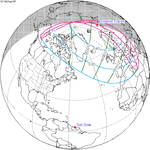 Partial |
1.2571 | |
Saros 123[edit]
This eclipse is a part of Saros series 123, repeating every 18 years, 11 days, and containing 70 events. The series started with a partial solar eclipse on April 29, 1074. It contains annular eclipses from July 2, 1182 through April 19, 1651; hybrid eclipses from April 30, 1669 through May 22, 1705; and total eclipses from June 3, 1723 through October 23, 1957. The series ends at member 70 as a partial eclipse on May 31, 2318. Its eclipses are tabulated in three columns; every third eclipse in the same column is one exeligmos apart, so they all cast shadows over approximately the same parts of the Earth.
The longest duration of annularity was produced by member 19 at 8 minutes, 7 seconds on November 9, 1398, and the longest duration of totality was produced by member 42 at 3 minutes, 27 seconds on July 27, 1813. All eclipses in this series occur at the Moon’s ascending node of orbit.[2]
| Series members 42–63 occur between 1801 and 2200: | ||
|---|---|---|
| 42 | 43 | 44 |
 July 27, 1813 |
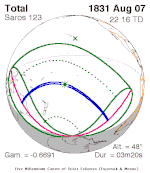 August 7, 1831 |
 August 18, 1849 |
| 45 | 46 | 47 |
 August 29, 1867 |
 September 8, 1885 |
 September 21, 1903 |
| 48 | 49 | 50 |
 October 1, 1921 |
 October 12, 1939 |
 October 23, 1957 |
| 51 | 52 | 53 |
 November 3, 1975 |
 November 13, 1993 |
 November 25, 2011 |
| 54 | 55 | 56 |
 December 5, 2029 |
 December 16, 2047 |
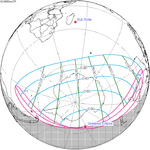 December 27, 2065 |
| 57 | 58 | 59 |
 January 7, 2084 |
 January 19, 2102 |
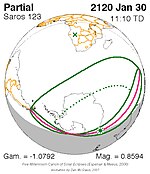 January 30, 2120 |
| 60 | 61 | 62 |
 February 9, 2138 |
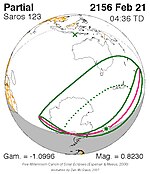 February 21, 2156 |
 March 3, 2174 |
| 63 | ||
 March 13, 2192 | ||
Metonic series[edit]
The metonic series repeats eclipses every 19 years (6939.69 days), lasting about 5 cycles. Eclipses occur in nearly the same calendar date. In addition, the octon subseries repeats 1/5 of that or every 3.8 years (1387.94 days). All eclipses in this table occur at the Moon's ascending node.
| 22 eclipse events between December 24, 1916 and July 31, 2000 | ||||
|---|---|---|---|---|
| December 24–25 | October 12–13 | July 31-Aug 1 | May 18–20 | March 7–8 |
| 91 | 93 | 95 | 97 | 99 |
| December 23, 1878 | October 12, 1882 | July 31, 1886 | May 18, 1890 | March 7, 1894 |
| 101 | 103 | 105 | 107 | 109 |
| December 23, 1897 | October 12, 1901 | August 1, 1905 | May 19, 1909 | March 8, 1913 |
| 111 | 113 | 115 | 117 | 119 |
 December 24, 1916 |
October 12, 1920 |  July 31, 1924 |
 May 19, 1928 |
 March 7, 1932 |
| 121 | 123 | 125 | 127 | 129 |
 December 25, 1935 |
 October 12, 1939 |
 August 1, 1943 |
 May 20, 1947 |
 March 7, 1951 |
| 131 | 133 | 135 | 137 | 139 |
 December 25, 1954 |
 October 12, 1958 |
 July 31, 1962 |
 May 20, 1966 |
 March 7, 1970 |
| 141 | 143 | 145 | 147 | 149 |
 December 24, 1973 |
 October 12, 1977 |
 July 31, 1981 |
 May 19, 1985 |
 March 7, 1989 |
| 151 | 153 | 155 | 157 | 159 |
 December 24, 1992 |
 October 12, 1996 |
 July 31, 2000 |
May 19, 2004 | March 7, 2008 |
| 161 | 163 | 165 | 167 | 169 |
| December 24, 2011 | October 13, 2015 | August 1, 2019 | May 19, 2023 | March 8, 2027 |
Notes[edit]
- ^ van Gent, R.H. "Solar- and Lunar-Eclipse Predictions from Antiquity to the Present". A Catalogue of Eclipse Cycles. Utrecht University. Retrieved 6 October 2018.
- ^ "NASA - Catalog of Solar Eclipses of Saros 123". eclipse.gsfc.nasa.gov.
References[edit]
- Earth visibility chart and eclipse statistics Eclipse Predictions by Fred Espenak, NASA/GSFC




